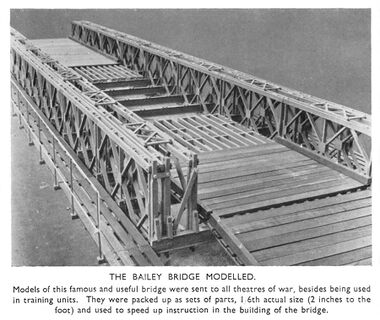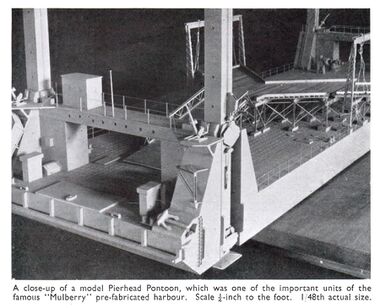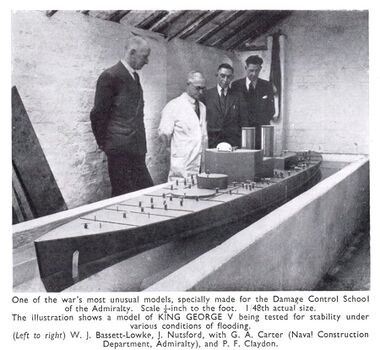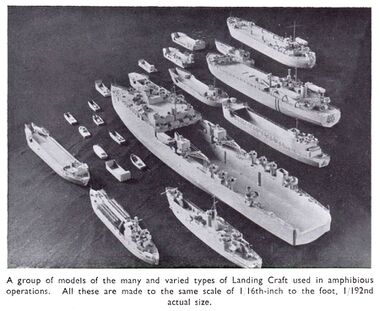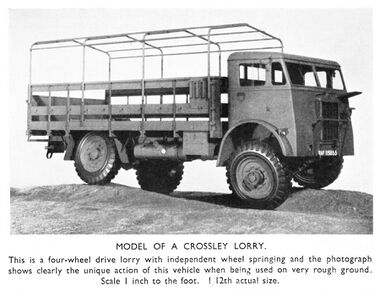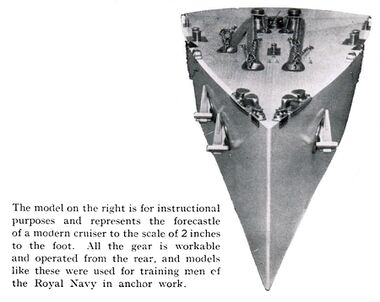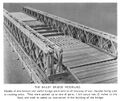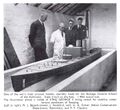Category:Bassett-Lowke in World War Two
D-Day Bailey Bridge model, Bassett-Lowke [image info]
D-Day Mulberry Harbour model, Bassett-Lowke [image info]
Scientific flotation model. W.J. Bassett-Lowke is the figure on the far left [image info]
D-Day landing craft models, Bassett-Lowke [image info]
Crossley Lorry, Bassett-Lowke [image info]
Working model of a ship's anchorwork, used for training Royal Navy personnel [image info]
Although Bassett-Lowke spent the First World War making precision machine tool components, they spent most of World War Two making ... models.
The Second World War involved far more technology than its predecessor, and required huge numbers of combatants to be trained not just in how to look after the components of a firearm, but also to be familiar with the workings of lorries, aircraft, advanced ship machinery and all sorts of other specialised military equipment. The armed forces needed quality training tools that could allow people to achieve familiarity with the workings and characteristics of complex pieces of machinery as quickly as possible, and three-dimensional models allowed this. Trainees could play with model vehicles, flip them over, test the moving pieces more quickly than on the actual units, and if a trainee made a mistake with a model, the consequences were less serious than if they made that mistake on the real equipment. Scale models were also more portable than the real thing, and could be moved around the country fairly easily.
Models were also needed to train "spotters" to recognise enemy ships and planes on sight and distinguish them form "friendly" craft, and were used in war-rooms for planning purposes.
The armed forces need a team of dedicated model-builders who could turn their hand to creating scaled-down copies of almost anything, and Bassett-Lowke's network of Northamptonshire fabricators fitted the bill nicely.
The "D-Day" landings
The most famous example of Bassett-Lowke's military modelling was the set of models produced for planning the Allies' invasion of Normandy in 1944, which involved a range of novel landing craft and devices such as a pre-assembled "Mulberry Harbour" whose pieces were to be sent across the channel and put together on-site on enemy territory, possibly under under battlefield conditions.
These models didn't just lets the planners check that the equipment would work and that it could be assembled on-site, and practice the operation in miniature, the models also lets the military personnel who'd be assembling the landing equipment get to really know the pieces of the complicated "construction kits" that they would be working with on the day. Engineers who would be assembling the "Bailey Bridges" also got to practice with large pre-packed 1/6-scale models.
The museum at Arromanches houses a large Bassett-Lowke model of the Mulberry Harbour and landing equipment.
External links
Media in category ‘Bassett-Lowke in World War Two’
The following 6 files are in this category, out of 6 total.
- Bailey Bridge model, 1-6-scale (Bassett-Lowke, WW2).jpg 1,200 × 1,011; 234 KB
- Crossley Lorry, 1-12-scale (Bassett-Lowke, WW2).jpg 1,200 × 920; 205 KB
- Flotation model, King George V, 1-48-scale (Bassett-Lowke, WW2).jpg 1,200 × 1,104; 235 KB
- Landing craft, 1-192-scale (Bassett-Lowke, WW2).jpg 1,200 × 981; 223 KB
- Mulberry Harbour pierhead pontoon, 1-48-scale (Bassett-Lowke, WW2).jpg 1,200 × 972; 246 KB
- Ship anchor-training model, Royal Navy, 1-6-scale (Bassett-Lowke, WW2).jpg 1,200 × 955; 130 KB
